Article by Dustin White
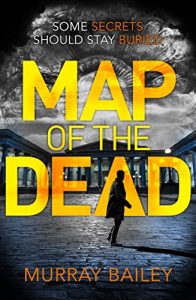
Map of the Dead, released in November 2016, was the second novel and first treasure hunt by English author Murray Bailey.
The challenge: solve the treasure hunt within the story about a hunt for ancient Egyptian treasure.
The prize: a custom made 18 karat golden pyramid.
The four stage puzzle on Murray’s website was straightforward enough but seemed to become more and more difficult while the answers were actually hidden in plain sight. The hunt took searchers on a journey looking for an elusive “man of gold” across England with detours through ancient and modern-day Egypt. Be the first to enter the correct solutions to all four stages to win. The four stages on the website provided guidance to what you should put in for the answers.
The story of Map of the Dead revolves around the main character, Alex MacLure, and his investigation of the death of a very close friend named Ellen Champion, when she digs up secret information that a group known as the Brotherhood of Levi wants to keep buried. Alex is joined by a character named Vanessa on his search for answers. I won’t give away the whole story (it’s thrilling by the way!) but we will touch upon elements of it to explain the treasure hunt that is woven through the pages. There are a lot of references to ancient Egypt that are important including King Tutankhamen, Nefertiti, Moses leading the Ibiru out of Egypt and the tale of a boy in ancient Egypt that is destined for greatness.
STAGE ONE
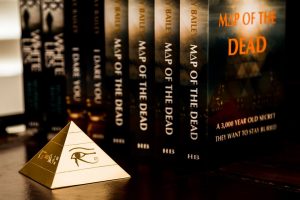 Alex comes into possession of Ellen’s iPhone. It is locked and requires a four digit pin to get into it. Alex had discovered in a book he had given Ellen as a gift had a string of numbers written into it and he suddenly remembered a string of numbers just like the ones he was looking at had been used to hide a secret code in a movie he and Ellen had watched together. There were three sets of numbers that could be broken apart to find a specific word on a specific line on a specific page of the book. The first set of numbers led to the discovery of the name: Isis (the Egyptian goddess). The second set of numbers had Alex find the word: is. And the final set of numbers led to the word: key. Alex exclaimed “She’s telling me Isis is the key!” He changes the letters into numbers and ISIS becomes 1515 and he uses this code to open the phone.
Alex comes into possession of Ellen’s iPhone. It is locked and requires a four digit pin to get into it. Alex had discovered in a book he had given Ellen as a gift had a string of numbers written into it and he suddenly remembered a string of numbers just like the ones he was looking at had been used to hide a secret code in a movie he and Ellen had watched together. There were three sets of numbers that could be broken apart to find a specific word on a specific line on a specific page of the book. The first set of numbers led to the discovery of the name: Isis (the Egyptian goddess). The second set of numbers had Alex find the word: is. And the final set of numbers led to the word: key. Alex exclaimed “She’s telling me Isis is the key!” He changes the letters into numbers and ISIS becomes 1515 and he uses this code to open the phone.
Entering the solution to stage one:
YOUR JOURNEY TO FIND THE GOLD BEGINS HERE
An incorrect answer on the site would provide the clue:
IT IS THE KEY YOU SEEK…
Solution: 1515
The solution to stage one was very simple and could be solved by anybody that has read the book cover to cover.
STAGE TWO
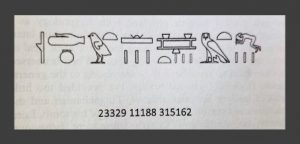 Stage two’s solution was nearly as simple to figure out. After you enter the solution to stage one you see the information stage two provides: THE NUMBERS WILL REVEAL and YOU SEEK SOMETHING BURIED. If you did read the book cover to cover, on the final page you’d notice that there is a string of numbers below some hieroglyphs (that turned out to also be extremely important) that appear to be the same kind of code that Alex had used to gain access to Ellen’s phone. The string of numbers are: 23329 11188 315162. These can be broken down to solve stage two. On page 23, line 32 and word 9 you’ll find the word FIND. Page 111, line 8 and word 8 is the word BURIED. And finally, page 315, line 16 and word number two says SARCOPHAGUS. After entering these words in a couple combinations you come to the correct solution to stage three, the word SARCOPHAGUS.
Stage two’s solution was nearly as simple to figure out. After you enter the solution to stage one you see the information stage two provides: THE NUMBERS WILL REVEAL and YOU SEEK SOMETHING BURIED. If you did read the book cover to cover, on the final page you’d notice that there is a string of numbers below some hieroglyphs (that turned out to also be extremely important) that appear to be the same kind of code that Alex had used to gain access to Ellen’s phone. The string of numbers are: 23329 11188 315162. These can be broken down to solve stage two. On page 23, line 32 and word 9 you’ll find the word FIND. Page 111, line 8 and word 8 is the word BURIED. And finally, page 315, line 16 and word number two says SARCOPHAGUS. After entering these words in a couple combinations you come to the correct solution to stage three, the word SARCOPHAGUS.
Entering the solution for stage two:
THE NUMBERS WILL REVEAL
An incorrect answer on the site would provide the clue:
YOU SEEK SOMETHING BURIED
Solution: SARCOPHAGUS
The method of finding the solution to stage two was given to searchers early on if they were paying attention.
STAGE THREE
This is where the puzzle becomes a LOT more complex. Bailey provided a hint to everyone subscribed through his website in September 2017 that said; “The hieroglyph messages at the start of each section of the book will indicate a location” , so we knew that the solution to stage three involved deciphering long strings of Egyptian hieroglyphs. Treasure hunters knew that the hint “THE PAGES WILL GUIDE YOU” provided this guidance but if you’re not an Egyptologist you have a lot of work ahead of you. Later we learned that we should also be piecing together a literal puzzle that is in the book. It took the better part of a month but my wife Deidra and I were able translate the hieroglyphs that are at the beginning of each section of the book. The sections are referred to as “The First, The Second” and so on. The translations are as follows:
The First: “Garden in the South”
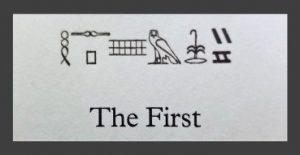
The Second: “Red dog (fox) by the river”
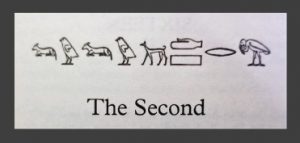
The Third: “Valley of water mongoose (otters)”

The Fourth: “Between the trees and the symbol (pi)”
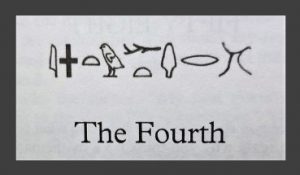
So we knew we were looking for some kind of garden in the south of England or Egypt, there was some sort of connection to a fox and otters, and something being between trees was important. It took a long time to decipher these clues. The other component of the hint provided “THAT IS NOT THE LOCATION YOU SEEK” again confirmed that we were indeed looking for a “LOCATION”.
Each chapter of Map of the Dead has a icon of sorts under the chapter number. There were single Egyptian hieroglyphs, characters from an ancient written language called cuneiform and other weird little symbols that we couldn’t quite figure out. Additional hints were provided by the author in October 2017 including a crucial hint to solve stage three: “The solution is also visual”.
By this time at least three other treasure hunters (led by somebody with the username hissyhissy, the eventual winner) had solved stage three and we felt a sense of urgency to play catch up. Deidra and I were eating breakfast at a restaurant later in October and she was really focusing on this “visual” clue. She noted that the weird symbols looked like they could be pieced together to make something. Once we got home, she took pictures of each icon that didn’t seem to fit any language we’d ever come across. She made quick work of piecing together these puzzle pieces and when I had seen what she was doing I told her “Hey, that looks like a maze!” She agreed and we began searching all over the internet, with fellow treasure hunter Coy Lothrop, for a maze that would fit with the translations we had figured out from the hieroglyphs in the four sections of the book.
At first, every time we found a suitable maze, we would enter it as the solution on the website to be told again and again “THAT IS NOT THE LOCATION YOU SEEK”. We then dived in a bit deeper to those translations and we found some interesting connections to a garden off the southern coast of Cornwall in England (Garden in the south, check), designed by a man named Alfred Fox (Red dog (fox) by the river, check), that’s name in the Cornish language is: Glynn Dowrgeun, meaning deep valley of otters (valley of the water mongoose (otters), check) and features a laurel cherry tree maze (between the trees and the symbol (pi), check). We had discovered the answer for stage three:
GLENDURGAN GARDEN!
Entering the solution for Stage three:
THE PAGES WILL GUIDE YOU
An incorrect answer on the site would provide the clue:
THAT IS NOT THE LOCATION YOU SEEK
Solution: GLENDURGAN GARDEN
Stage three was very complicated but it made complete sense and if you solved the puzzles it led you to the exact right spot where you needed to be to find the solution to stage four.

STAGE FOUR
Everybody working on stage four had been taunted by the phrase “SEEK AND YOU WILL FIND” for more than a year straight. Nearly everybody instantly made the connection to Matthew Chapter 7 Verse 7 from the New Testament of the Bible: “Ask, and it will be given you. Seek, and you will find. Knock, and it will be opened for you.” But what should we do with that? Early on, the consensus was that we should use the solutions from the prior stages in conjunction with the new information relating to stage four. It turns out that we were correct but we massively over-complicated the final solution.
Don’t get me wrong, it was extremely complex, and an early clue from Murray suggested such: “The solution to the final stage is multifaceted and includes Jewish Gematria.” So right off the bat we understood the solution to stage four was going to be something that requires multiple steps to solve and that we could be helped with figuring out the solution by applying the use of Jewish Gematria.
I think it’s safe to assume that there weren’t many treasure hunters familiar with what Jewish Gematria is but we had all read a passage in the book where Alex chats with Vanessa’s uncle about numbers and turning numbers into words and vice versa through Gematria. Overnight, there was suddenly a contingent of Gematria experts in the treasure hunting community! Every phrase that seemed like a likly clue in the book was converted to numbers via a Jewish Gematria calculator and those numbers were applied to all sorts of places in the book.
Alternatively, all the numbers in the book were converted into words with the Jewish Gematria calculator and the book was again combed over. Many months later another clue was provided by the author that ended up connecting to the Gematria clue, it said: “April 5 is important or, from a different perspective you could cross-check with October 3”. These dates appear on the same page in the book and are an excerpt from Howard Carter’s (the archaeologist that discovered King Tutankhamen tomb in 1922) personal diary. April 5 is pretty straight forward, it is the date that Carter’s financier Lord Carnarvon passes away. Oct 3 11 4 7 35 appears shortly after the mention of Lord Carnarvon’s death and for a long time, treasure hunters were trying to figure out what to do with that information.
Murray has since credited treasure hunter Clayton Watson with being first to figuring out what was to be done with this information, he added 10 (October is the tenth month), 3, 11, 4, 7, 35 and that equals 70. If you put 70 into the Jewish Gematria calculator you will find the word Ayin, the Hebrew word for “eye”. The Eye of Horus is engraved on the Golden Pyramid and always seemed important. The solution to stage four was in a churchyard and one of the tombstones at the site had an eye carved into it. The Eye of Horus is the chapter icon for chapter 67 in Map of the Dead and it has an prominent “2” drawn under it. This “eye” clue was meant to draw you to this chapter and realize that the number two was important.
As time went by, Murray offered up hints on finding the solution on a monthly basis. The hints that were the most helpful were:
“The answer to stage 4 is a name (two words). It is not a place.”
“For stage 4 you are looking for a man of gold – but don’t expect to find his name in the book.”
“There is a church connection.”
Many treasure hunters poured thousands of hours into looking for this elusive “man of gold” all over England and Egypt. My wife and I searched every place that we could think of in England that had an Egyptian connection where we might find 1515 relating to something or someplace that housed a sarcophagus and featured a maze or labyrinth. Most of our searching was around London. We had theories that we were absolutely sure were correct only to be told time and time again by the website: “YOU HAVE NOT FOUND THE SOLUTION”.
We were missing something major. Way back in October 2017, when we received via email the confirmations of the translations of the hieroglyphs for the sections of the book for those that hadn’t already translated it, the string of hieroglyphs at the back of the book were provided, they said: “Drawn lines (directions) of the roads to the dead” which could be interpreted as “Map of the Dead”. However, this translation also means that we should draw lines to the dead.
This is exactly what Beth Coolin did on December 2nd, 2018 when she drew a simple line from the eastern exit of the maze at Glendurgan Garden “to the dead” that were nearest. The line was 15º east southeast from the maze that was the solution to stage three. The line went straight through a church and graveyard. This church is named St. Mawnan and St. Stephen’s Church and it is located in Cornwall in Mawnan, England. This church is one mile (less than two kilometers) from Glendurgan Garden.
Chapter 50 had a strange icon with two marks at 90 degrees to one another. On closer inspection, one is a sarcophagus. Murray had given another clue in the section “The Fourth” hieroglyphs which could also be interpreted as triangle cross and circle (from the pi symbol). Going 90 degrees from the St. Mawnan (ie 15 degrees church for the same distance takes you to another church thereby using the 1515). Joining this to the maze creates the triangle. The St. Mawnan church is famous for having tombstones with strange symbols and part of a Celtic cross in one wall – which is in fact a circle. All of these confirmed the location.
Everybody working on this treasure hunt was so determined to make it more complicated than it perhaps was. Like I mentioned before, I was laser focused on the solution being somewhere around London, more than 250 miles away! To give my wife credit she kept her options open and searched all over England. There was still the task of locating the mysterious “man of gold”. Beth Coolin, the treasure hunter behind the username “hissyhissy” discovered that the “man of gold” was John Kempthorne and that there was a double meaning behind the clue that “2 is important”. Two being the two Saints that the church is named for and also that there are two graves in the churchyard that have the name John Kempthorne on them.
There is a brochure available for this historic cemetery that highlights interesting graves on the property entitled: “A Walk Around St. Mawnan Churchyard.” This description of Kempthrone’s grave is on the brochure: “John Kempthorne (1836-1896) Gold prospector in New Zealand Murdered together with 3 other prospectors in the Maungatapu Mountain. They were “waylaid, robbed and barbarously murdered by a gang of four bushrangers” known as the Burgess Gang. The murder was infamous in the region and a memorial to the victims was erected at the scene.”
Beth Coolin had discovered that John Kempthorne was a gold prospector that had tragically passed away in New Zealand. His family had a tombstone installed for him over an empty grave at St. Mawnan’s churchyard. There was another clue to this. Only two chapters had the same icon: cuneiform that means “ka”. The ka was the spirit of a body rather than the physical body itself. There are two tombstones that refer to John Kempthorne’s body in the churchyard (the second is for both him and his son, also John Kempthorne) but his body isn’t beneath either. Beth Coolin had discovered the “man of gold”.
Entering the solution for stage four:
SEEK AND YOU WILL FIND
An incorrect answer on the site would provide the clue:
YOU HAVE NOT FOUND THE SOLUTION
Solution: JOHN KEMPTHORNE
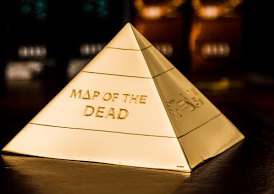 Though we all wanted and dreamed to be the searchers that found John Kempthorne first and enter the solution to stage four to claim the Golden Pyramid for winning the Map of the Dead Treasure Hunt, there’s no denying that we were all extremely impressed with Beth’s accomplishment and her name is enshrined atop the leaderboard of Murray’s website. Deidra and I became the second team to locate and identify John Kempthorne as the “man of gold” and my username appears directly underneath “hissyhissy”. Even though we didn’t win the solid gold pyramid, it was a huge accomplishment that we had figured out the solution to stage four before the solution was published and it felt extremely satisfying.
Though we all wanted and dreamed to be the searchers that found John Kempthorne first and enter the solution to stage four to claim the Golden Pyramid for winning the Map of the Dead Treasure Hunt, there’s no denying that we were all extremely impressed with Beth’s accomplishment and her name is enshrined atop the leaderboard of Murray’s website. Deidra and I became the second team to locate and identify John Kempthorne as the “man of gold” and my username appears directly underneath “hissyhissy”. Even though we didn’t win the solid gold pyramid, it was a huge accomplishment that we had figured out the solution to stage four before the solution was published and it felt extremely satisfying.
Murray Bailey is awarding us the sarcophagus he intended to bury as part of the treasure hunt along with a signed copy of the book. We want to thank Murray for that kindness. A special thank you to Mike Cowling of the Cowlazars YouTube vlog for introducing me and many others to Map of the Dead.
Congratulations to Beth Coolin and to Murray Bailey on the completion of a fantastic treasure hunt!
Q&A with author Murray Bailey
Dustin White: What was the main inspiration for creating a treasure hunt within a novel?
Murray Bailey: The inspiration came from my old friend Andrew Reeves, inventor of the Isis Adventure. I thought he was suggesting it to promote his puzzles, turned out that I’d misunderstood and it was just a throw away idea. I only had an outline idea for the story at that stage so it gave me focus. I put the Isis puzzle in because it worked well rather than promoting it. I’ve not pointed this out to anyone, but Champion is Andrew Reeves’ partners surname. This was another subtle clue as to the importance of Isis and 1515 in the treasure hunt.
DW: Were you satisfied with the end result of the treasure hunt component of the book?
MB: I feel it could have been cleverer and didn’t spend as much time on it as I would if I started again. However I have no idea what I’d do. Maybe I’d research other treasure hunts since the only one I was aware of was the 1970s Masquerade by Kit Williams. I’d spent many hours as a teenager trying to figure that out.
DW: How long did you expect the treasure hunt to last?
MB: I always intended it to last about 18 months and to start providing hints so that it was solved.
DW: You provided a lot of crucial hints throughout this nearly two year long treasure hunt. What did you think would help people most? Was there any grand plan for the order you released them? Personally, we found the hints provided after finishing the Church Parade supplemental treasure hunt the most helpful and the hint about finding the “Man of gold”.
MB: No I didn’t plan it. I was concerned about saying so much that a whole bunch of people would realize quickly – or people feel they had to go to the church. I’d thought that the gematria would help but in hindsight I think it was a distraction for some. I thought the April and October clues were good and might be too obvious. Not only did you derive eye (pointing to the 2 and eye-like symbol on the gravestone) but also sun rise and sun set on those approximate dates. The sun being so critical to the ancient Egyptian religion, I incorrectly thought it was a huge clue that the church was nearby. Church Parade (a separate treasure hunt on Murray Bailey’s website) was of course also a huge clue that churches were important.
DW: “Secret messages aren’t just for the ancient Egyptians but may still lead you to the gold”, was printed on the first page of the book following the cover and you told us in a hint that that message was intended as a guide. Is it “Secret messages = 1515 (stage one answer), ancient Egyptians = SARCOPHAGUS (stage two answer), may still (mays/maze stage 3’s answer is Glendurgan Garden, the main attraction is a hedge maze), lead you to gold = John Kempthorne (the man of gold, John Kempthorne was a gold prospector)” or was the sentence a different kind of guide?
MB: Yes but also a double meaning. You could follow instructions in the book following the word gold that would lead you to important chapters with directions in. Incidentally I originally planned it to say “golden one” implying a person but this didn’t work for the directions.
DW: How satisfying was it for you that more than one person cracked the final solution of who the “Man of Gold” was before the solution was revealed to the general public?
MB: Very! I knew a whole bunch of people were close. The usual suspects but also a few who were emailing me with ideas rather than participating in Facebook. Interestingly Beth only contacted me when she had the answers. She appears to be quite enigmatic.
DW: Was the word “SEEK” specifically any part of the solution to the treasure hunt or a red herring? (Stage one: “It is the key you SEEK”, Stage two: “You SEEK something buried”, Stage 3: “That is not the location you SEEK”, Stage four: “SEEK and you will find”.)
MB: Neither a clue nor a deliberate red herring. I wanted the last to sound a bit biblical thereby hinting at a church.
DW: What drew you to using ancient Egypt in Map of the Dead?
MB: I’ve always been intrigued by it and had read a few non-fiction books including “Tutankhamun the exodus conspiracy” which provides evidence that Moses was probably a priest of Osiris. It took me four years of research and writing and re-writing before I was happy with it.
DW: I loved Yanhamu’s tale! Are we going to get more of his tale in his own book or short story? Were there any clues to the whereabouts of the solution to the treasure hunt hidden in his story?
MB: Although I’m most of the way through my 4th Ash Carter (Singapore) thriller, I have been haunted by Yanhamu’s story ever since writing the second instalment in “Secrets of the Dead”. So much so that this morning I began work on “Lost Pharaoh – Yanhamu’s story” (working title). As for clues, there was nothing deliberate but subconsciously I may have put clues in all over the place.
DW: Isis is the key. Were you specifically looking to use Isis and 1515 in the solution the whole time or specifically because the final solution for the puzzle was located 15º ESE from the answer to stage three?
MB: I was “amazed” that it all fitted. I know Cornwall and Glendurgan well so I looked at it when I was thinking about the story. When I found the strange markings at St Mawnan’s church, I couldn’t believe it. Then I realised the right Isosceles triangle connected with the 15 -15. I can tell you I was astounded. At that point I didn’t know about Kempthorne and the circle in the church wall that was part of a Celtic cross. It seemed like kismet.
DW: The solution to the number code in the back of the book that (page number, line number, and word number) had two solutions: 23329 11188 315162 could be worked out to page 23, line 32, word 9 gives you: FIND. However if you instead used page 233, line 2, word 9 instead provides: NEVER. The other two numbers had only one solution of BURIED for page 111, line 8, word 8 and SARCOPHAGUS for page 315, line 16, word 2. Are both answers correct or was one unintentional? FIND BURIED SARCOPHAGUS was ultimately the goal but NEVER BURIED SARCOPHAGUS also ties into the solution to stage four nicely because John Kempthorn was not buried in the grave at the final solution spot, he was buried in New Zealand.
MB: Unfortunately that only worked in the book. I’d intended people to buy the paperback but it didn’t seem fair for the large US contingent entering, so I introduced the kindle version which had to be more straightforward.
DW: Did any treasure hunters send you theories that made complete sense that you wish were actually part of the treasure hunt?
MB: Not complete re: all the clues but, yes I thought some were smarter than mine – although the weird coincidence if everything working does make me like my solution. The most common guesses related to coordinates, which struck me as too obvious. However one solution is worthy of mention: London Zoo. Clayton Watson managed to match the icon in chapter 4 to the penguin enclosure. Just a coincidence although he had a good justification for his answer. He was also the first to realize the importance of “eye” in the hunt, so kudos goes to Clayton if not the prize.
DW: Secrets of the Dead was recently released (it’s really good and I think everyone should go buy it and Map of the Dead if they haven’t already), was there anything at all in that story that could’ve helped anybody with the Map of the Dead treasure hunt like there was in another work of yours, Singapore 52 (another great novel and the way the hint for Map of the Dead was inserted blew me away!)?
MB: No! I’ve had it with treasure hunts – for the time being anyway.
DW: The first page of Chapter 30 was something my wife and I looked at for months trying to figure out if it was a clue or not regarding the text message the main character Alex sends to Vanessa: “looking 4ward 2 cing you sunday” and Vanessa replied “I get into KGX at 15:44 will come straight over x” All the other texts from Alex had used proper grammar and punctuation so this stood out like a sore thumb! Was this a red herring to get treasure hunters to focus on and draw their attention away from the solution? “4ward 2” led us to search Tower 42 in London and its surroundings for about a month, we thought Vanessa’s x at the end of her message was X marks the spot!
MB: Not a deliberate red herring. In fact there were no deliberate red herrings. The 42 wasn’t a clue. I needed Vanessa to use KGX so it seemed logical to use abbreviations. I guess I should have been more consistent!
DW: Did you think it was risky having the solution to stage four being so close to the the physical location answer to stage three? Glendurgan Garden (stage three answer) is only about a mile (less than two kilometers) from St. Mawnan and St. Stephen’s churchyard?
MB: Yes. I was concerned it’d be solved quickly after 3 – especially by Someone local who knew about the strange markings if not JK. I later found the pdf online and was then concerned someone might just guess. By the way the distance is 1.618 kilometres (Phi – the Golden ratio which is important in Alex solving the map puzzle in the story).
DW: How did you find out the story behind the “Man of Gold”: John Kempthorne?
MB: When I visited the churches, I was looking for something relevant. The online pdf you’ve referenced was a leaflet that I picked up. It doesn’t mention that his body isn’t there or that there are effectively 2 grave stones to him in the churchyard. It also doesn’t show any of the strange symbols or Celtic cross.
DW: Is there anything else you’d like to tell the treasure hunters that spent so much time trying to find the solutions to Map of the Dead
MB: I’m in awe of your dedication and inventiveness. I hope that it’s been fun even if you didn’t solve the 4th stage. Of course my motivation was to promote my writing rather than my treasure hunt skills. Although financially it’s not worked out as I expected ( only my local newspaper picked up the story) it has been an interesting journey for me. Including exchanging messages with some fascinating people I now consider friends.
Thank you so much for the adventure you took us on, Murray!

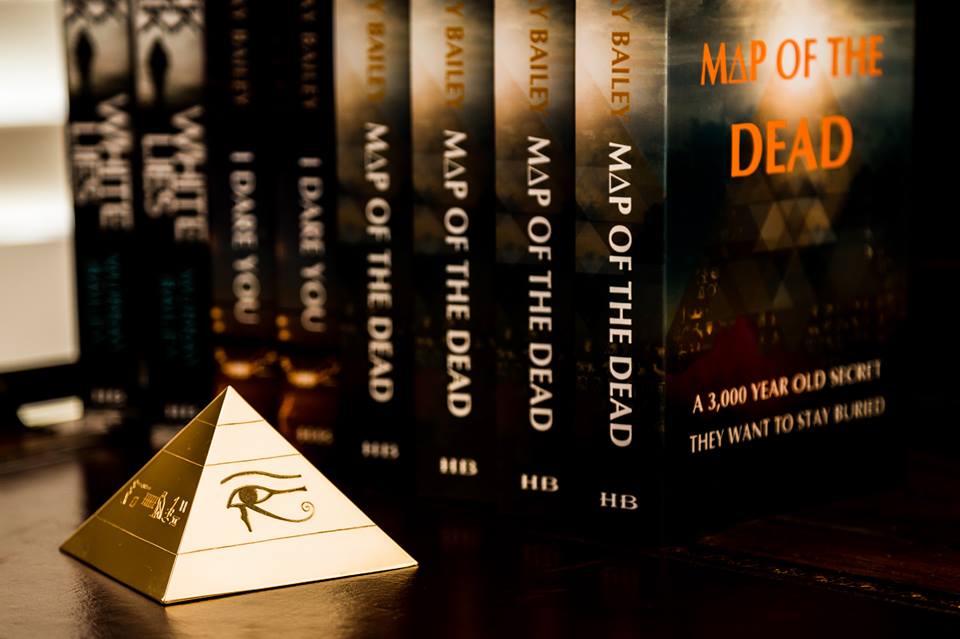
This was fascinating. Congrats, Dustin and Deidra.
Congrats also to Beth.
Murray, it may not have paid off for you financially, but still it had a fine treasure hunt feel to it. Congrats to you also.
Thanks Murray, for another chance to explore a new adventure and also read a fine story whilst doing so. I did also manage to work out that the maze was at Glendurgan, but knew that unless I discovered the full answers I would never find the final location. It would be great to have another hunt in the future but I’ll keep an eye out for your new books anyway.